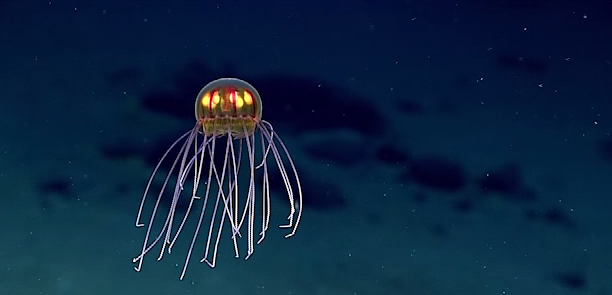This newly discovered jellyfish looks like a ‘beautiful’ Pixar character
The "stunningly beautiful jellyfish" was discovered last week

There's a lot we don't know about the deep ocean, and just as we send ships into space to discover what's above us, vessels dive into the Earth's watery depths to uncover what lies below.
Take this bizarre-looking jellyfish (which totally looks like it belongs in a Pixar animated feature). The "stunningly beautiful jellyfish" was discovered last week during a National Oceanic and Atmospheric Administration expedition into one of the deepest ocean regions in the world, according to the agency.
The expedition's remotely operated vehicle (ROV) captured footage of the hydromedusa, a type of tiny jellyfish, at 3,700 meters (12,139 feet) below. Researchers believe it belongs to the genus Crossota, which currently includes five species.
At the start of this video, you can see that the mesmerizing creature has a long and short set of tentacles, with the long tentacles extended out evenly while its bell pulsates. Researchers note that this behavior suggests the jellyfish is in an ambush predator mode.
Inside the bell, you can see red radial canals connecting to bright yellow points, which researchers believe are the jellyfish's reproductive glands.
The jellyfish was found during the fourth dive of the nearly four-month expedition in and around the Mariana Trench, located in the Pacific to the east of the Philippines. Dive four focused on what has been dubbed the Enigma Seamount, "given its informal name because we don't know much about it," according to NOAA.
Most other underwater mountains in this area "have a flat top with steep, smooth sides radiating out into narrow ridges," according to NOAA, but the Enigma Seamount "is more circular in form and the sides are much less smooth."
A field of small, sedimented balls that we have tentatively identified as the amoeba Gromia sphaerica or a close relative. We saw huge number of these throughout the dive.
"We were interested in sampling here because we believe that this seamount, and others that lie along a northwest-southeast trend, may have formed on the boundary between the ancient Pacific Plate to the northeast and a much younger plate to the southwest," reads the daily log of the expedition.
The curious deep-sea jellyfish isn't the only thing researchers saw during the Enigma Seamount dive. They also saw "high concentrations of small, rounded balls" that could be sponges but have tentatively been identified as a single-celled amoeba species -- "biologists are still unsure."
Copyright: Washington Post
Join our commenting forum
Join thought-provoking conversations, follow other Independent readers and see their replies
Comments
Bookmark popover
Removed from bookmarks